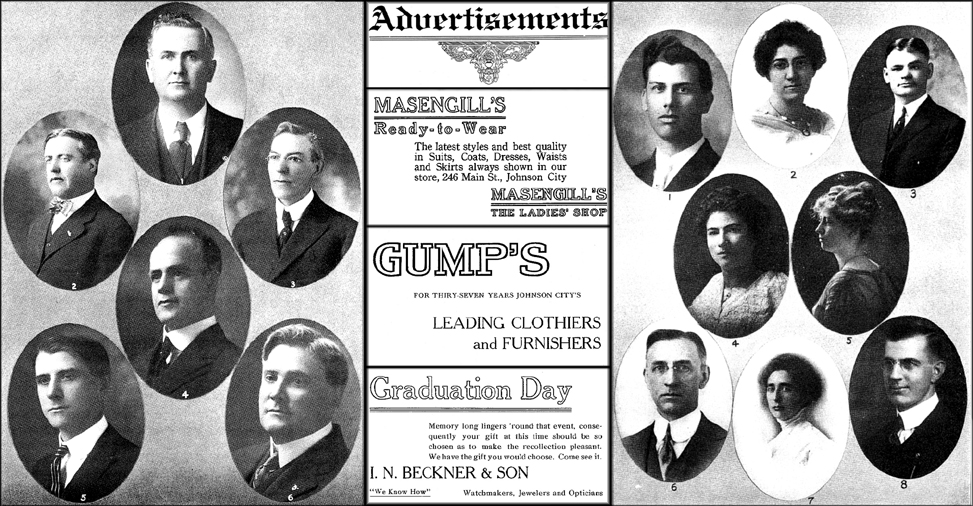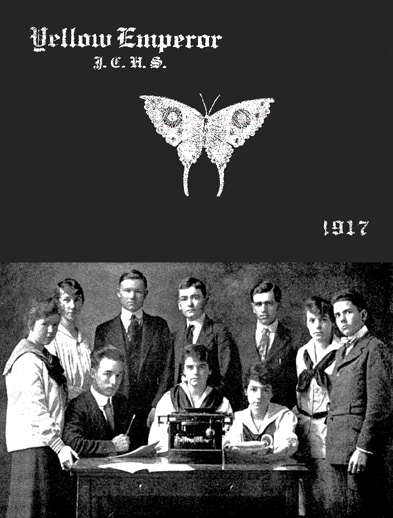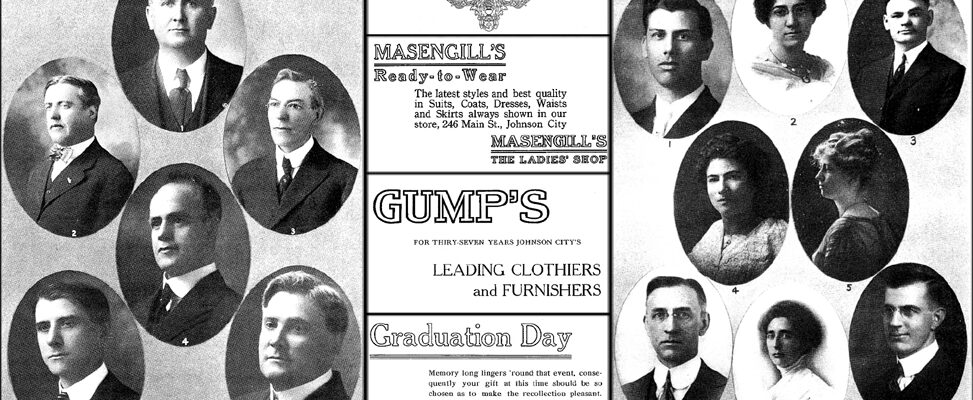Today's feature is dedicated to the memory of the late Mrs. Louise Bond Alley who copied her mother's 1917 Science Hill High School annual, “Yellow Emperor,” for me shortly before her passing. I am hoping that some of our Johnson City Press readers will recognize a few of the names.
The 70-page publication, revealing 38 graduates, was the first one from the school that had numbered pages and advertisements at the back of it. It acquired its name from an orange and brown North American butterfly described as having a swift dodging flight.

The Board of Education (see photo) that year were 1. Dr. W.J. Matthews, 2. Horace Miller, 3. J.T. Browning, 4. Frank B. St. John, 5. J.E. Brading and 6. George T. Wofford.
Faculty members (see photo) who served the institution were 1. J.L. Gilbert (commercial arts), 2. Lena Mills (domestic science), 3. W.I. Williams (history), 4. Una M. Jones (modern languages), 5. Floy Harris (Latin), 6. P.S. Barnes (superintendent), 7. Lucy Hatcher (mathematics, future principal) and 8. J.A. Tinsley (principal). Not shown are E.K. Hickam (manual training) and Dean Slagle (science).
The editorial staff (see photo) was comprised of (sitting) James Remine, Anne Huddle (editor), Bess Remine, (standing) Helen Browder, Louise Cox, Oliver Robertson, Melville Smith, H.C. Hart, Nancy Weaver and Maurice Cardwell. Not pictured was Lorna Whiteside..

The senior class officers were Fred Locket (president), Oliver Robertson (vice president), Mildred Wade (secretary) and Bess Remine (treasurer). Their clever class motto was “We’ve crossed the hills, the mountains are in view.”
The only sports listed were girls' basketball and boys' baseball. A “Who’s Who in the Senior Class” listed 24 senior superlatives: most popular, most agreeable, most bashful, most sarcastic, best athlete, most conceited, brainiest, biggest flirt, most fickle, most kiddish, most original liar, most lovable, prettiest, cutest, most attractive, sissiest, sportiest, most studious, sweetest, most stylish, darlingest, most vivacious, most English and wittiest.
Two verses of the class poem read: “Farewell, thou dear, old rocky hill, Farewell forevermore; Thru mem'ry we'll be keeping still, When days with thee are o'er. However oft we may have dreamed, Of the future soon to be, Tis harder now than once it seemed, Oh, hill, to part with thee!
Unlike the class poem, the class song spoke of the thrill of graduating and being set free. The chorus read, “Little Jimmie Remine, Here's Altai Boring and Anne Huddle, And Buford Conner and Jimmie Humphries. All standing here you see. Oh, won't we have a jolly time. Oh, won't we have a jolly time. Oh, seniors, put your books away. We're all set free. And Floyd, you get your Ford cranked and stand before the gate, For we just must ride your Lizzie when we all graduate. We'll drive to the Majestic (Theatre) we're hired for forty “frog skins,” And we guess we'll be given our precious, precious “sheep skins.”
An amusing observation was declared in the Class History portion of the yearbook: “The class of 1917 claims the distinction of having fooled more teachers, ridden barebacked and unafraid on more unbroken ponies, absorbed more science, evaded more mathematics and eluded more examinations, remaining still unscathed than any other class ever turned loose upon an unsuspecting world.”
My favorite witticism from a joke page was Paul asking Jack if a damaging fire was of incendiary origin. Jack answered by saying “no” because he felt that the building had been set on fire.
The student societies were listed that included the president's name and club yell if provided: Adelphian Literary Society (James Remine, “Stand 'em on their head. Stand 'em on their feet. Adelphians, Adelphians. They can't be beat.”), Ossolian Literary Society (Bess Remine), Jefferson Literary Society (Oliver Robertson, “Rah, Rah, Rah. Row, Row, Row. Boom (stomp foot). Jeffersonian, Jeffersonian, Jeffersonian.”), Francis E. Willard Society (Ruth Allison, “Chick-a-lac-a, chick a-lac-chog-chog-chog. Francis E. Willard rog, rog, rog. We are the Willards. We are the best. We are the girls of the WLS.”), Victorian Literary Society (Lorna Whiteside), Athenian Literary Society (Katherine Sells) and YMCA (Clarence Miller).
There were 39 sponsors of the yearbook: The Hub, W.M. Silver Company, Unaka National Bank, The Hart & Houston Store, Hecht's Bakery, Inc., R.C. Hunter Agency, The City National Bank, Wm. Silver Optometrist, Ferguson Drug Co., Tennessee Electrical Supply Co., City Shoe Store, Johnson City Steam Laundry, The Kiosk Ice Cream Parlors, Connor Brothers Furniture Co., Gunnar Teilmann's Florist, Colonial Hotel, J.E. Crouch, Miller's Drug Store, Masengill's Ladies' Shop, C.P. Faw & Co., Boston Shoe Repairing Co., Lockett Brothers Co., White City Laundry, Jones-Vance Drug Store, The Frank Taylor Store, I.N. Beckner & Son, Smith Shoe & Clothing Co., The Bon Marche Ice Cream Parlors, Dosser Brothers, Mountcastle-Summers Hardware Co., Gump's Leading Clothiers and Furnishers, Coca Cola, H.R. Parrott Motor Co., Davis-Fain Co., Brading-Sells Lumber Co., Garden Drug Co., Tranum Brothers (with its famous rocking horse sign), Muse-Whitlock Co. and The Charley Cargille Studio.
Additional ending thoughts about leaving the old institute of learning can be noted in the first and last stanzas of “Good Bye Science Hill,” written by Anne Huddle:
“Dear Science Hill, we've loved you long, And now we must bid you good bye. We've filled you with laughter, We've thrilled you with song, And sometimes we've wished we could cry. Your walls they have witnessed a wearyful fight, and rung to a won Waterloo, But oh in our triumph, we are dreary tonight. Goodbye, dear old school, to you.
“How cold, still and lonely, how weary you seem, A last wistful look and we'll go; Oh, will you remember the Class of Seventeen, The class that you comforted so? The shadows enfold you, it's drawing tonight, A smarting tear blinds each eye; Alas, but it is stinging and stabbing our sight, God bless you old school, good bye!”
In March 1961, 44 years later, my classmates and I experienced those same melancholy feelings when we too bid our final adieu to the same old nostalgic brick building that we affectionately referred to as “the Hill.” We finished the last three months of our senior year at a new modern school on John Exum Parkway.

Comments are closed.